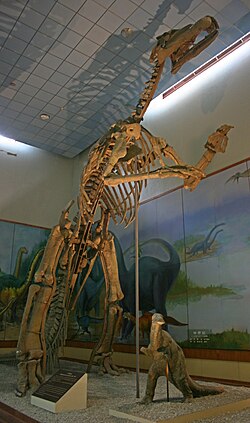Huaxiaosaurus
|
Huaxiaosaurus Temporal range: Late Cretaceous, 70 Ma |
|
|---|---|
 |
|
| Restored skeleton, with inaccurately pronated arms | |
| Scientific classification | |
| Kingdom: | Animalia |
| Phylum: | Chordata |
| Class: | Reptilia |
| Clade: | Dinosauria |
| Order: | †Ornithischia |
| Suborder: | †Ornithopoda |
| Family: | †Hadrosauridae |
| Subfamily: | †Saurolophinae |
| Genus: |
†Huaxiaosaurus Zhao, Wang & Li, 2011 |
| Type species | |
|
†Huaxiaosaurus aigahtens Zhao, Wang & Li, 2011 |
|
Huaxiaosaurus is a genus of saurolophine hadrosaurid dinosaur, discovered in Cretaceous rocks of Zhucheng, Shandong, China. A large hadrosaur, some of its estimated dimensions include a length of 18.7 metres (61 ft) and a height of 11.3 metres (37 ft) (in a tripodal posture) makes it one of the largest Ornithopods known. It lived in the same time and place as Shantungosaurus and Zhuchengosaurus, and is almost certainly the same animal as Shantungosaurus.
In March 2008 during excavations in the quarry near the city of Zhucheng, the province of Shandong, bones were found belonging to the prehistoric species. In addition to the fossils of many different species, the skeleton of a huge hadrosaur was found. The excavation uncovered a block the size of twenty square metres containing this giant beast. After a careful examination it was concluded that the bones belonged to a giant new species of dinosaur, different from others like Shantungosaurus and Zhuchengosaurus. In 2011 came the scientific description, sponsored by Wang Kebai and Li Dunjing. A new species of dinosaur had been named. The genus name is derived from Huaxia - the ancient word for China. The specific epithet is given in Chinese, (jù dà), and means giant. Aigahtens is identical to the Latin word giganteus. Huaxiaosaurus should not be confused with Huaxiasaurus, a nomen nudum, and the later name for it, Huaxiagnathus.
...
Wikipedia
